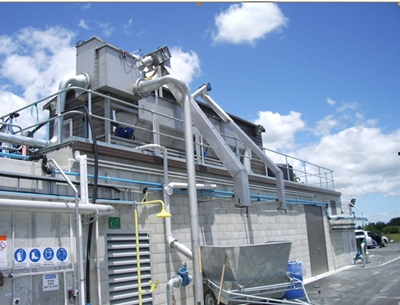The town of Te Aroha in New Zealand’s North Island has installed a modern intensive-treatment sewage system, replacing the facultative or oxidation pond treatment that has been widely used by urban councils since the 1960s.
The new system – a type widely applicable to Australia and New Zealand – uses a combined screening and grit removal package plant, prior to a Membrane Biological Reactor (MBR). The old ponds at Te Aroha have been retained for storm water balancing.
Matamata-Piako District Council (MPDC) commissioned the system in 2006 to service the municipality of about 4000. Kaimai Valley Services (KVS), the Works division of MPDC, undertake operation and maintenance of the plant. A recent assessment by KVS’s wastewater team concluded that the system in general was performing well, with the screening and grit removal performing very effectively.
“We were looking at increasing the wastewater throughput of the system, so we examined the performance of the screen and grit removal quite closely to see if it could handle the extra load,” said Hugh Ratsey, KVS Wastewater Team Leader.
“A number of MBRs have been installed in New Zealand. We were the third or fourth council to install this type of plant. We knew that one of them had issues with the screen and grit removal process. This affected the working of the membrane, which is delicate and easily blocked or torn by debris if this is not screened and separated out.
“An inspection of our own system revealed only a very small amount of fibrous material. We were pleasantly surprised. You expect a little bit, but apart from that it was very clean.”
The wastewater team also carried out an analysis of the sludge at the bottom of the tank and found only very fine particles.
“We examined the sludge quite closely. The median particle size was 100 microns, which is pretty small. The grit removal plant is designed to take out 95 per cent of particles above 250 microns in size, Mr Ratsey said.
The CST Wastewater Solutions STU/CR combined inlet screen and grit removal package plant was supplied to Matamata-Piako District Council by Smith and Loveless. Similar technology has been employed by CST Wastewater Solutions in Tasmania, Queensland and NSW, including the Olympic site at Homebush.
The Te Aroha installation comprises a compact, completely enclosed system that:
- Screens solids from the raw influent.
- Lifts the screenings out of the wastewater and simultaneously washes the screenings.
- De-waters the screenings, which are discharged down into conveniently placed skips.
- Separates the sand particles or grit.
- Lifts and de-waters the grit, which is discharged into the same skip or a separate skip.
- Offers optional grease removal.
The system handles flow rates up to 200 litres per second, with a 3-5mm circular holes screen, dewatering screenings to between 25-35 per cent, and removes 95 per cent of grit particles above 200 microns and SG 2.1.
“We would definitely recommend CST’s screening and grit removal plant to other councils. A couple of other types of units elsewhere in the country haven’t performed anything like as well as the product we’ve got,” Mr Ratsey said.
Pieter Groenewegen, of CST Wastewater Solutions, said that the key to the STU/C combined inlet screen and grit removal system is that it offers efficient and cost effective solids separation before the wastewater reaches the MBR plant to make sure the membranes do not block.
“The screen cleanly removes rags and other debris, while the grit removal stage gives good separation of particles from the solution, with no accumulation in the reactor.”

